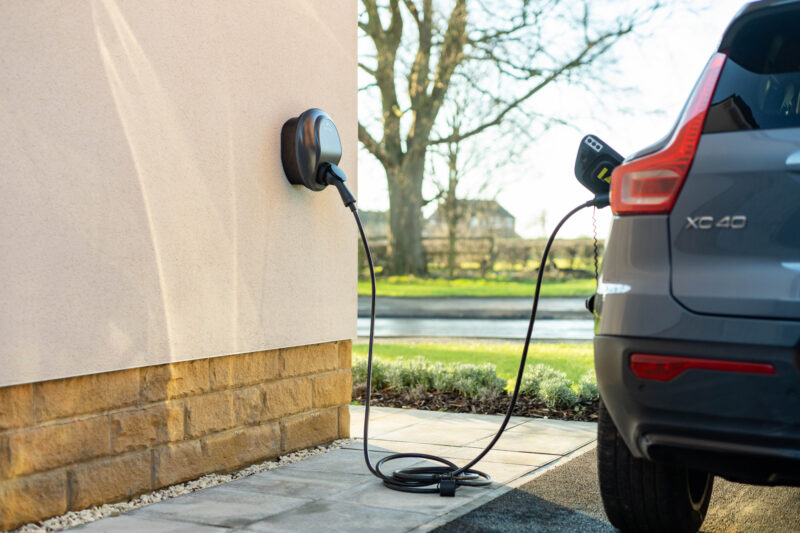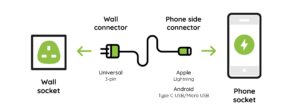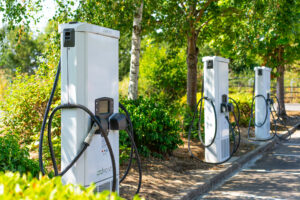EV Charging Connector Types and Speeds
A guide covering the different types of electric vehicle connectors and charging speeds.
Last updated: Sept 18, 2025 • 6 min read

EV charger types
Similar to phone charging cables, car charging cables tend to have two connectors, one that plugs into the vehicle socket and the other into the chargepoint itself.
The type of connector you need varies by vehicle and the power rating ("speed") of the chargepoint.*
- Electric vehicles either have a Type 1 or Type 2 socket for slow/fast charging and CHAdeMO or CCS for DC rapid charging.**
- Most slow/fast chargepoints have a Type 2 socket. Occasionally they will have a cable attached instead. All DC rapid charging stations have a cable attached with mostly a CHAdeMO and a CCS connector.
- Most EV drivers purchase a portable charging cable that matches their vehicle’s Type 1 or Type 2 socket so that they can charge on public networks.
* This guide is based on the UK and may not include complete information for all countries.
** With the exception of Tesla Model X and Model S vehicles to date, which use Type 2 connectors for DC rapids. Adapters that allow to charge these Tesla models via CHAdeMO or CCS connectors are available.
Vehicle side EV connector types
Electric car charging sockets plug into your vehicle and can be thought of the same as the phone-side charging connectors on your Apple or Android phone charging cable. Depending on which phone/car you have, different connectors will fit into your phone/car socket.


Slow & Fast Charging
Alternating Current (AC)
Typically used for top-up charging at home, work and destinations, there are two types of AC vehicle-side connectors.
| AC connector type | Typical Power Ratings | Approx range per hour charging** | Features |
|---|---|---|---|
Type 1
|
3.6kW 7.4kW |
12.5 miles 25 miles |
|
Type 2
|
3.6kW 7.4kW 22kW (three-phase)* |
12.5 miles 25 miles 75 miles |
|
* Some models of Renault Zoe can draw 43kW, giving 145 miles of range per hour (for the Zoe, 43kW is classed as an en route rapid charger).
** Assumes 60kWh full battery electric vehicle (BEV) with a range of 200 miles.
Tip: Three-phase power is relatively rare in the UK. There are almost no three-phase power systems in homes, but there are some in a few larger commercial buildings. Most public chargepoints are single-phase 7kW devices.
What are Type 1 and Type 2 EV chargers?
Type 1 and Type 2 refer to different connectors found on EV charging cables. A Type 2 connector has 7 pins, can carry three-phase power and is widely used for electric cars across the EU. This connector comes with an in-built locking mechanism, so no one can easily remove or tamper with your charging cable without your permission.
A Type 1 connector is the standard plug used for EV charging cables in the US. It’s different to a Type 2 connector with its 5 pins, no locking mechanism and ability to carry single phase power only.
Type 2 sockets are universally found on untethered home and public chargepoints. So, unless your EV has a Type 1 connector socket on the vehicle side, a charging cable with Type 2 connectors on both ends is likely the most suitable option for you.
At Pod Point you can get a home charger, including installation, installed in as little as 2 hours from £999. Find out more.

Rapid Charging
Direct Current (DC)
Typically used for en route rapid charging, there are three types of DC car-side connectors. Most DC rapid charging stations will have cables with both a CHAdeMO and CCS connector attached so you will just have to choose which fits to your vehicle socket. To protect the battery, rapid chargers do not consistently charge at their maximum power rating.
| DC connector type | Typical Power Ratings | Approx range per 30 mins charging* | Features |
|---|---|---|---|
CHAdeMO
|
50kW 100kW |
75 miles 150 miles |
|
Combined Charging System (CCS)
|
50kW 150kW** 350kW*** |
75 miles 225 miles 525 miles |
|
Type 2
|
150kW 250kW**** |
225 miles 375 miles |
|
* Assumes 60kWh full battery electric vehicle (BEV) with a range of 200 miles.
** 150kW CCS rapid chargers will become very common, but across the UK most are still just 50kW.
*** A handful of 350kW CCS chargers exist, however it is not yet common place.
**** 250kW Tesla Superchargers are starting to be rolled out.
Tip: You can find out your car's AC and DC sockets and maximum charging rates in our vehicle guides.
Chargepoint side electric car connector types
Typically used for top-up charging at home, work and destinations, there is really only one kind of chargepoint socket, though some might occasionally use a traditional 3-pin plug to charge from a wall socket as an emergency backup.
The Type 2 chargepoint socket is universal, and can be thought of in a similar way to the wall socket for charging iPhones or Android phones (i.e. the socket is the same for each, but the cable is specific to the car/phone type).
Slow & Fast Chargers
Alternating Current (AC)
The “Type 2” socket is the Europe-wide, universal socket for charging electric cars. You can charge any type of car from it, so long as you have the appropriate charging cable for your car - much the same as charging Apple or Android phones from a wall socket.
| AC connector type | Typical Power Ratings | Approx. range per hour charging* |
Features |
|---|---|---|---|
Type 2
|
7.4kW (single-phase) |
25 miles 75 miles |
|
3-pin plug 
|
2.3kW | 8 miles |
|
* Assumes 60kWh battery electric vehicle (BEV).
Rapid Chargers
Direct Current (DC)
Most DC units have tethered cables with both CHAdeMO and CCS connectors that match the car-side sockets, so there are no chargepoint-side DC sockets.
Which is the Most Popular EV Connector Type?
Type 2 is the EU standard for home charging, making this the safest, and most cost-efficient way to charge your vehicle. In the public charging domain however, you are likely to run into different connector types, such as CHAdeMO and CCS.

